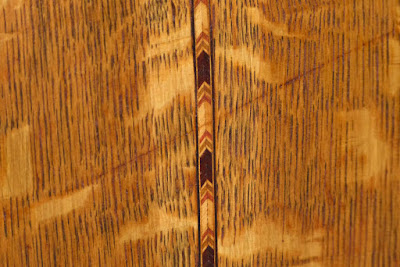1920s Oscar Schmidt-made Stella Oak Concert Guitar
This bruised-but-lovely old Stella is just slightly larger than usual (13 1/2" on the lower bout) and has gorgeous quartersawn oak on its back. I'm being a little conservative by dating it to the 20s, as well, because it probably dates from the late teens instead. This guitar has had a rich -- hee hee -- life. It came in with a bolt holding the neck pat, a 1960s Harmony Stella pickguard screwed to the top, frets so squared-off you could slice carrots on them, a funky home-made bridge, loose bracing, and about 1/3 of the back/side seams coming undone. Yes -- it was also refinished somewhere along the line, too, and got a chunk of its headstock (!) replaced.
I'm glad my customer had it sent here for work, though, as the "roughly playable" description it was advertised as was nothing but a bunch of hooey. It's now a real player and has a good, cutting, lower-mids aggressive sound to it. It's a lot of fun to pick out bass runs on this as it digs-in like an archtop guitar. Some of that extra depth must certainly come from the oak back and sides, though, as I've always found oak to add an extra degree of depth and sustain to otherwise similar builds. I like the stuff!
Work included a neck reset, fret level/dress, new compensated bone bridge, seam repairs, replacement pickguard (in the style of the 1960s Harmony one I pulled off... but much thinner and better), new nut, yadda yadda. It got everything taken care of and plays like it should.
The big old C-shaped neck profile slows me down for closed-position mid-neck chords but for "old time" and "country blues" cats, it's perfect.
Check out the treble side of the 'stock. See it? Someone replaced that bit with a hunk of fine-grain spruce. I love it! They doweled it in as well so it's going to remain functional, too.
Pearl dots in a... mystery wood... board. This stuff acts like rosewood but certainly doesn't look it. Curious, huh?
The top is solid spruce and has no (!) cracks.
Too bad my bridge cut is blown out -- it's like a massive mandolin bridge and has a compensated top and B-string slot. I find that using a big old piece of bone can really improve response and volume on these tailpiece boxes. Besides -- it looks handsome as it matches the white trim.
Thankfully the original tailpiece never went missing. The three little holes at the upper end of it were added by someone to hold tiny machine screws that held a felted pad in place on the bottom of the tail so that it didn't rattle on the top. It seems to me like an inelegant solution when all you have to do is string it up with the strings wrapping under the tailpiece edge to solve that issue. It'd then raise itself off of the top automatically. Sigh.
Isn't that nice? Oak, oak, oak. I love oak.
After resetting the neck I decided to put the handyman's bolt back in the hole it came from... but now serving a function as a strap-button retainer. Someone had mucked-up the back of the heel anyhow, so why not?













Comments